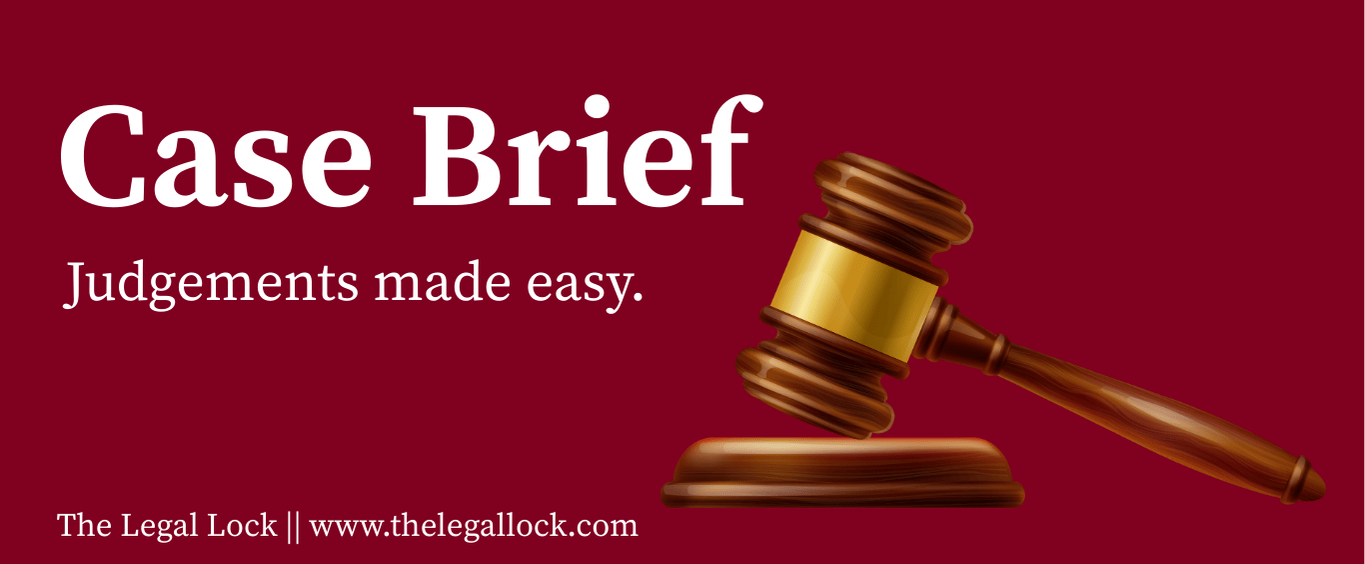CASE BRIEF: SAJEEV PILLAI V. VENUKUNNAPALLI & ANR

| CASE NAME | Sajeev Pillai v. VenuKunnapalli & Anr |
| CITATION | AIRONLINE 2019 KER 773 |
| COURT | Delhi High Court |
| Bench | V Shircy |
| Date of Decision | 11 December, 2019 |
INTRODUCTION
Sajeev Pillai v. Venu Kunnapalli & Anr. is a significant case concerning the moral rights of authors under copyright law. The dispute centers around the rights of an author after the assignment of copyright, specifically addressing the scope of protection under Section 57 of the Copyright Act of 1957. The case explores the delicate balance between commercial interests in film production and the moral rights of original creators, particularly in the context of authorship credits and script modifications.
The case gains particular significance in the context of India’s growing film industry, where disputes over creative rights and authorship have become increasingly common. It brings to the forefront the crucial distinction between economic rights that can be transferred through assignment and moral rights that persist with the original creator. The Kerala High Court’s examination of these issues provides valuable guidance on protecting authors’ rights while ensuring the commercial viability of creative projects, especially in the context of high-budget film productions where multiple stakeholders’ interests need to be balanced.
FACTS
- Sajeev Pillai, the appellant, was a film director and scriptwriter who had researched the history of ‘Mamankam’, an ancient festival held on the banks of the Bharathapuzha river in Kerala during the 14th to 19th century.
- Pillai wrote a script based on this research and considered it his dream project.
- While searching for a producer, Pillai met Venu Kunnapalli and subsequently signed an MoU with Kavya Film Company, which was associated with Kunnapalli.
- Initially appointed as the director, Pillai’s services were terminated after two shooting schedules, and he was replaced by another director.
- The film’s shooting was completed thereafter, which Pillai alleged involved mutilation, distortion, and modification of his original script.
- Pillai had assigned his work, including story, script, screenplay, and dialogue, to the respondents for Rs. 3 Lakh.
- He filed a civil suit seeking various reliefs, including an interim injunction to restrain the respondents from releasing the film without providing adequate authorship credits as per industry standards.
ISSUES
- Whether an author retains special rights to claim authorship of work even after assignment under Section 57(1) of the Copyright Act?
- Whether the author can restrain modification or distortion of their work after assignment if it prejudices their honor or reputation?
- How to balance the author’s moral rights with the commercial interests of film production?
ARGUMENTS
Appellant’s Arguments:
- Claimed right to authorship credits despite the assignment of copyright.
- Argued that modifications to the script were prejudicial to his honor and reputation.
- Sought protection under Section 57 of the Copyright Act for moral rights.
Respondent’s Arguments:
- Contended that assignment of copyright for consideration extinguished all rights.
- Argued that they had complete rights over the script after paying Rs. 3 Lakh.
- Emphasized the commercial implications of delaying the film’s release.
DECISION
The Kerala High Court examined the delicate balance between protecting moral rights of authors and preserving commercial interests in film production. The appellant, Sajeev Pillai, claimed protection under Section 57 of the Copyright Act, arguing that his moral rights persisted despite the assignment of copyright to the respondents. The respondents contested this, maintaining that the payment of Rs. 3 Lakh for the script transferred all rights to them.
The Court conducted a detailed analysis of Section 57 of the Copyright Act, emphasizing its two distinct components. First, it established that under Section 57(1)(a), an author retains the right to claim authorship of their work even after assignment. Second, it clarified that Section 57(1)(b) provides both preventive and compensatory remedies – the right to restrain modifications prejudicial to the author’s honor or reputation and the right to claim damages for such modifications.
The Court adopted a pragmatic approach in crafting its remedy. Recognizing the substantial commercial implications of delaying the film’s release while also acknowledging the author’s moral rights, it devised a balanced solution. The Court permitted the film’s release but directed that no one’s name be displayed as the scriptwriter until the disposal of the main suit. Furthermore, recognizing the time-sensitive nature of the dispute, it ordered the trial court to dispose of the case within six months.
The Kerala High Court’s decision established important principles regarding moral rights under copyright law:
- It was confirmed that Section 57(1)(a) of the Copyright Act preserves an author’s right to claim authorship even after assignment.
- Recognized two distinct rights under Section 57(1)(b):
- Right to restrain distortion, mutilation, or modification prejudicial to honor/reputation
- Right to claim damages for such modifications
- Acknowledged the need to balance competing interests by:
- Allowing the film’s release to proceed
- Directing that no one’s name be displayed as scriptwriter until disposal of the suit
- Ordering expedited disposal of the main suit within six months
ANALYSIS
The Kerala High Court’s ruling in Sajeev Pillai v. Venu Kunnapalli & Anr. Significantly advances India’s copyright jurisprudence, particularly concerning the moral rights of authors in the entertainment industry. The Court’s interpretation provides a sophisticated understanding of how moral rights operate independently of economic rights in creative works. By affirming the persistence of moral rights post-assignment, the judgment establishes crucial protections for creators while acknowledging the practical realities of commercial film production.
The Court’s methodology demonstrates judicial pragmatism in balancing competing interests. While it recognized the fundamental importance of protecting an author’s moral rights, it also showed awareness of the commercial implications of film production. This balanced approach provides valuable guidance for future disputes in the entertainment industry, where conflicts between creative control and commercial interests are common. The decision suggests that courts can craft remedies that protect moral rights without unnecessarily impeding commercial projects.
The judgment also contributes significantly to the procedural aspects of copyright protection in the film industry. By ordering an expedited timeline for the main suit, the Court acknowledged the time-sensitive nature of film releases while ensuring that the author’s rights receive timely consideration. This approach sets a useful precedent for managing similar disputes in the future, where both creative rights and commercial timelines need careful consideration.
The case sets a notable precedent for protecting creative endeavors in India’s rapidly growing film industry. It emphasizes that while commercial considerations are important, they cannot completely override the fundamental moral rights of creators. This approach ensures that authors’ contributions are appropriately recognized and protected while allowing the industry to function efficiently. The decision provides a framework for resolving similar disputes in the future, potentially reducing uncertainty in film production and protecting both creative and commercial interests.
The judgment significantly contributes to Indian copyright jurisprudence in several ways:
- Reinforces the distinction between economic rights (which can be assigned) and moral rights (which persist after assignment) under copyright law.
- Demonstrates judicial pragmatism in balancing creative rights with commercial realities by finding a middle ground that protects both parties’ interests.
- Emphasizes the enduring nature of moral rights in creative works, particularly in the film industry, where collaborative efforts often involve multiple stakeholders.
- Establishes a precedent for protecting authors’ moral rights while ensuring commercial projects aren’t unduly hindered.
The Court’s approach provides valuable guidance for similar disputes in the entertainment industry, particularly regarding:
- The scope of moral rights post-assignment
- The balance between creative control and commercial interests
- The importance of proper attribution in creative works
- The need for expeditious resolution of such disputes to minimize commercial impact
This case stands as a significant precedent for protecting authors’ moral rights in the Indian entertainment industry while acknowledging the practical realities of commercial film production.
In essence, the Court’s decision reinforces the judiciary’s role in protecting creative rights while fostering a viable commercial environment for the film industry. The ruling strikes a crucial balance between preserving authors’ moral rights and acknowledging the practical needs of film production. This interpretation provides clear guidelines for future cases involving similar conflicts between creative rights and commercial interests in the entertainment industry.






